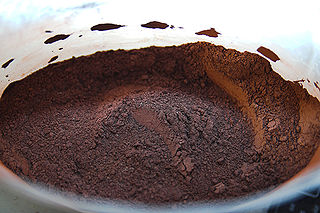
Thermite is a pyrotechnic composition of metal powder, which serves as fuel, and metal oxide. When ignited by heat, thermite undergoes an exothermic reduction-oxidation (redox) reaction. Most varieties are not explosive, but can create brief bursts of heat and high temperature in a small area. Its form of action is similar to that of other fuel-oxidizer mixtures, such as black powder.

Fireworks are a class of low explosive pyrotechnic devices used for aesthetic and entertainment purposes. The most common use of a firework is as part of a fireworks display, a display of the effects produced by firework devices. Fireworks competitions are also regularly held at a number of places.
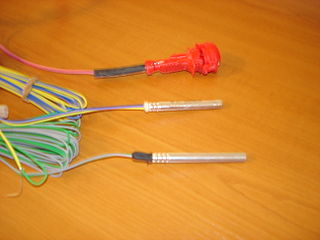
A detonator, frequently a blasting cap, is a device used to trigger an explosive device. Detonators can be chemically, mechanically, or electrically initiated, the latter two being the most common.

Pyrotechnics is the science of using materials capable of undergoing self-contained and self-sustained exothermic chemical reactions for the production of heat, light, gas, smoke and/or sound. Its etymology stems from the Greek words pyro ("fire") and tekhnikos. Pyrotechnics include not only the manufacture of fireworks but items such as safety matches, oxygen candles, explosive bolts and fasteners, components of the automotive airbag and gas pressure blasting in mining, quarrying and demolition.

A shell is a payload-carrying projectile that, as opposed to shot, contains an explosive or other filling, though modern usage sometimes includes large solid projectiles properly termed shot. Solid shot may contain a pyrotechnic compound if a tracer or spotting charge is used. Originally, it was called a "bombshell", but "shell" has come to be unambiguous in a military context.

A Roman candle is a traditional type of firework that ejects one or more stars or exploding shells. Roman candles come in a variety of sizes, from 6 mm (1/4") diameter for consumers, up to 8 cm (3") diameter in professional fireworks displays.

A sparkler is a type of hand-held firework that burns slowly while emitting colored flames, sparks, and other effects.

In an explosive, pyrotechnic device, or military munition, a fuse is the part of the device that initiates function. In common usage, the word fuse is used indiscriminately. However, when being specific, the term fuse describes a simple pyrotechnic initiating device, like the cord on a firecracker whereas the term fuze is sometimes used when referring to a more sophisticated ignition device incorporating mechanical and/or electronic components, such as a proximity fuze for an M107 artillery shell, magnetic or acoustic fuze on a sea mine, spring-loaded grenade fuze, pencil detonator, or anti-handling device.

Pyrotechnic stars are pellets or simply pieces of pyrotechnic composition which may contain metal powders, salts or other compounds that, when ignited, burn a certain color or make a certain spark effect. They are a part of all projectile-type fireworks. The most common is the aerial shell. When watching this firework, it will launch into the sky, burning a lifting charge. Once the shell has attained proper altitude, due to other mechanisms within the firework, it will ignite the stars.
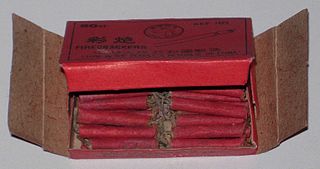
A squib is a miniature explosive device used in a wide range of industries, from special effects to military applications. It resembles a tiny stick of dynamite, both in appearance and construction, although with considerably less explosive power. Squibs consist of two electrical leads which are separated by a plug of insulating material, a small bridge wire or electrical resistance heater, and a bead of heat-sensitive chemical composition in which the bridge wire is embedded. Squibs can be used for generating mechanical force, or to provide pyrotechnic effects for both film and live theatrics. Squibs can be used for shattering or propelling a variety of materials.
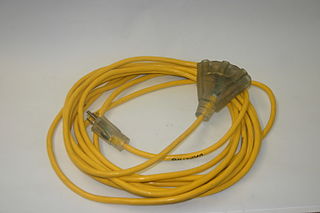
An extension cord, power extender, drop cord, or extension lead is a length of flexible electrical power cable (flex) with a plug on one end and one or more sockets on the other end. The term usually refers to mains extensions but is also used to refer to extensions for other types of cabling. If the plug and power outlet are of different types, the term "adapter cord" may be used. Most extension cords range from around two to thirty feet in length although they are made up to 300 feet in length.
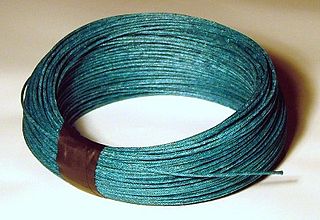
A visco fuse is a higher-quality fuse used for consumer fireworks. It is most commonly colored green or red, and is found as a twisted, coated strand. It is also used to create delays in the firing of multiple firework displays.

The MRUD is a plastic bodied, convex rectangular directional type anti-personnel mine designed to wound or kill by fragmentation. It is broadly similar to the M18A1 Claymore mine.
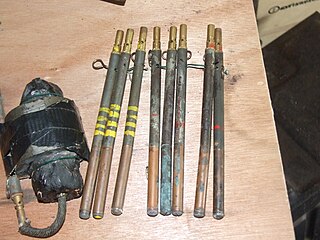
A pencil detonator or time pencil is a time fuze designed to be connected to a detonator or short length of safety fuse. They are about the same size and shape as a pencil, hence the name. They were introduced during World War II.

The Model 39 "Eihandgranate", M39 or Eierhandgranate 39 was a German fragmentation hand grenade introduced in 1939 and produced until the end of World War II.
The NR-413 is a Belgian trip wire activated anti-personnel stake mine. The main body of the mine is wine bottle shaped, with an NR 410 tripwire fuse screwed into a fuse well on the top of the mine. Under the fuse well is a detonator and a row of booster pellets. Wrapped around the detonator and booster pellets is the main charge. An internally square cross-sectioned steel wire is coiled around the outside of the mine, which give a fragmentation effect. The mine produces 600 fragments with a velocity of approximately 1,660 metres per second. It has an effective range of around 15 metres. A variant is produced with a cast steel fragmentation jacket.
A pyrotechnic initiator is a device containing a pyrotechnic composition used primarily to ignite other, more difficult-to-ignite materials, e.g. thermites, gas generators, and solid-fuel rockets. The name is often used also for the compositions themselves.
Thermalite a specific type of fuse used in pyrotechnic applications. The product was designed to be used in cross matching safety fuses of the Bickford type. As safety fuse is designed to neither give nor take fire through the heavy fuse jacket, ignition may be achieved by punching a hole perpendicular to and through a safety fuse powder core, threading a piece of Thermalite or similar igniter cord through the hole, then gently squeezing the safety fuse with pliers or similar to bring the powder core into contact with the igniter cord. The Thermalite could be ignited by a match, or more certainly by a purpose made igniter, similar to a wire sparkler.
The M549 is a High-Explosive Rocket Assisted (HERA) 155 mm howitzer round developed for use by the US Military.














